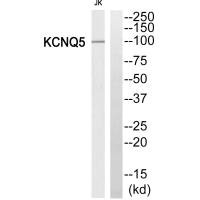
Western blot analysis of extracts from Jurkat cells, using KCNQ5 antibody.
KCNQ5 Antibody
CSB-PA876430
ApplicationsWestern Blot, ELISA
Product group Antibodies
ReactivityHuman
TargetKCNQ5
Overview
- SupplierCusabio
- Product NameKCNQ5 Antibody
- Delivery Days Customer20
- ApplicationsWestern Blot, ELISA
- CertificationResearch Use Only
- ClonalityPolyclonal
- ConjugateUnconjugated
- Gene ID56479
- Target nameKCNQ5
- Target descriptionpotassium voltage-gated channel subfamily Q member 5
- Target synonymsKQT-like 5; Kv7.5; MRD46; potassium channel protein; potassium channel subunit alpha KvLQT5; potassium channel, voltage gated KQT-like subfamily Q, member 5; potassium voltage-gated channel subfamily KQT member 5; voltage-gated potassium channel subunit Kv7.5
- HostRabbit
- IsotypeIgG
- Protein IDQ9NR82
- Protein NamePotassium voltage-gated channel subfamily KQT member 5
- Scientific DescriptionProbably important in the regulation of neuronal excitability. Associates with KCNQ3 to form a potassium channel which contributes to M-type current, a slowly activating and deactivating potassium conductance which plays a critical role in determining the subthreshold electrical excitability of neurons. May contribute, with other potassium channels, to the molecular diversity of a heterogeneous population of M-channels, varying in kinetic and pharmacological properties, which underlie this physiologically important current. Insensitive to tetraethylammonium, but inhibited by barium, linopirdine and XE991. Activated by niflumic acid and the anticonvulsant retigabine. Muscarine suppresses KCNQ5 current in Xenopus oocytes in which cloned KCNQ5 channels were coexpressed with M1 muscarinic receptors. Lerche C., J. Biol. Chem. 275:22395-22400(2000). Mungall A.J., Nature 425:805-811(2003). Schroeder B.C., J. Biol. Chem. 275:24089-24095(2000).
- ReactivityHuman
- Storage Instruction-20°C or -80°C
- UNSPSC12352203
